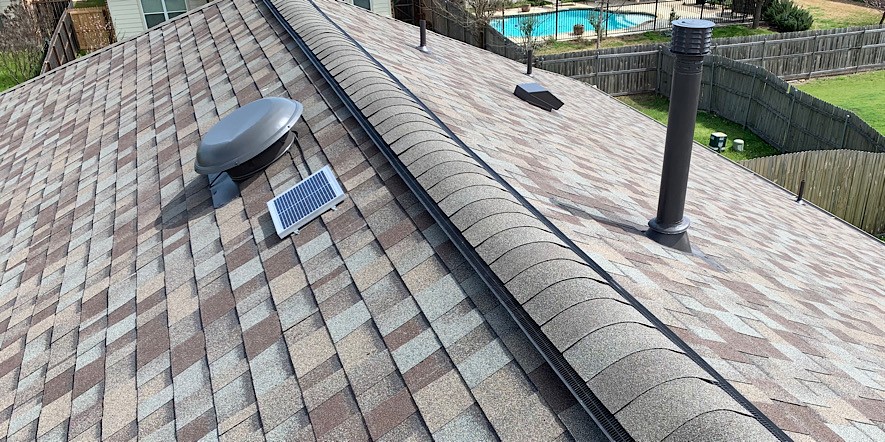A well-ventilated roof and attic are essential components of a comfortable, energy-efficient, and healthy home. Optimizing ventilation in your roof system can provide numerous benefits, such as improved temperature regulation, extended roof lifespan, and reduced energy costs. As the leading and most trusted residential roofing contractor in New Hampshire and Southern Maine, J. Carnes & Son Roofing specializes in assessing and enhancing roof ventilation systems to ensure the best performance and longevity for your home’s roofing materials and components. In this blog post, we will discuss the significance of proper roof ventilation, explore the advantages it offers, delve into common ventilation issues homeowners may encounter, and share valuable tips for evaluating and improving the ventilation of your attic and roof system.
Properly designed and maintained roof ventilation systems can significantly impact the comfort, health, and energy efficiency of your home, preventing potential issues such as moisture damage and heat buildup. With the expert guidance of J. Carnes & Son Roofing, you can identify potential ventilation problems and implement effective solutions to enhance your home’s roof system and ensure its long-term function and durability. In the following sections, we will discuss the benefits of proper roof ventilation, the indicators of common ventilation issues, and provide essential guidance on optimizing your attic and roof ventilation system for lasting performance and improved energy efficiency.
Improve Your Home’s Roof Ventilation for Enhanced Comfort and Energy Efficiency
Benefits of Proper Roof Ventilation
A well-designed roof ventilation system provides numerous advantages for your home, including:
1. Temperature Regulation: Proper ventilation prevents heat buildup in your attic and roof system during the summer months, helping to maintain comfortable indoor temperatures and reducing reliance on air conditioning systems.
2. Moisture Control: Ventilation reduces attic humidity, preventing moisture-related issues such as mold growth, wood rot, and insulation damage, which can compromise your home’s structural integrity and air quality.
3. Energy Efficiency: By promoting consistent temperatures throughout the house and reducing cooling loads, proper roof ventilation can lead to lower energy consumption and reduced utility bills.
4. Roof Longevity: Efficient ventilation helps prevent damage caused by heat and moisture, extending the life of your roofing materials and avoiding costly repairs or replacements.
Common Roof Ventilation Issues
Homeowners should remain vigilant for signs of common roof ventilation problems, such as:
1. Inadequate Ventilation: Insufficient ventilation can lead to issues such as excess heat buildup, increased energy consumption, and shorter roof lifespan. Ensuring a balanced ventilation system with both intake and exhaust vents is key.
2. Blocked Vents: Debris, dirt, or insulation can block vents, impeding airflow and reducing the efficiency of your ventilation system. Regular inspections and timely clean-up will help keep your vents clear and functional.
3. Condensation: Warning signs of high humidity in your attic, such as condensation on windows or rust on metallic components, may indicate inadequate ventilation and require immediate attention.
4. Mold and Mildew: Moisture issues in your attic can lead to mold and mildew growth, posing health risks and damaging your home’s structure. Proper ventilation can keep humidity levels in check and prevent mold problems.
Tips for Evaluating and Improving Your Roof Ventilation System
Improve your roof’s performance and longevity by following these essential guidelines for optimizing your attic and roof ventilation:
1. Assessment: Consult with a reputable and experienced contractor like J. Carnes & Son Roofing to evaluate your current attic and roof ventilation system, identifying any issues and recommending necessary upgrades.
2. Balanced Ventilation: Ensure proper balance between intake (soffit or eave) vents and exhaust (ridge or gable) vents to maintain consistent airflow and efficient temperature regulation throughout your attic and roof system.
3. Insulation Management: Avoid packing insulation too close to the roof deck, as it may block airflow between soffits and ridge vents. Ensure insulation extends to the eaves, with proper vent chutes in place to maintain a clear path for airflow.
4. Air Sealing: Seal any gaps or cracks in your attic’s floor, walls, and ceiling to prevent conditioned air from escaping and outside air from infiltrating your living spaces. This ensures optimal energy efficiency and thermal performance in conjunction with your roof ventilation system.
5. Routine Inspections: Periodic attic and roof inspections can help you identify potential ventilation issues, such as blocked vents, moisture concerns, or insulation discrepancies. Address problems promptly to maintain the ongoing efficiency and lifespan of your roof system.
Conclusion
Optimizing your home’s roof ventilation is essential for maintaining a comfortable, energy-efficient, and healthy living environment. By understanding the benefits of proper ventilation, being aware of common issues, and partnering with an experienced roofing contractor like J. Carnes & Son Roofing, you can ensure the best performance and longevity for your home’s roofing materials and components. Contact our team of professional New Hampshire roofers today to schedule a roof ventilation assessment and take the necessary steps to enhance your home’s comfort, energy efficiency, and durability with a properly ventilated attic and roof system.

